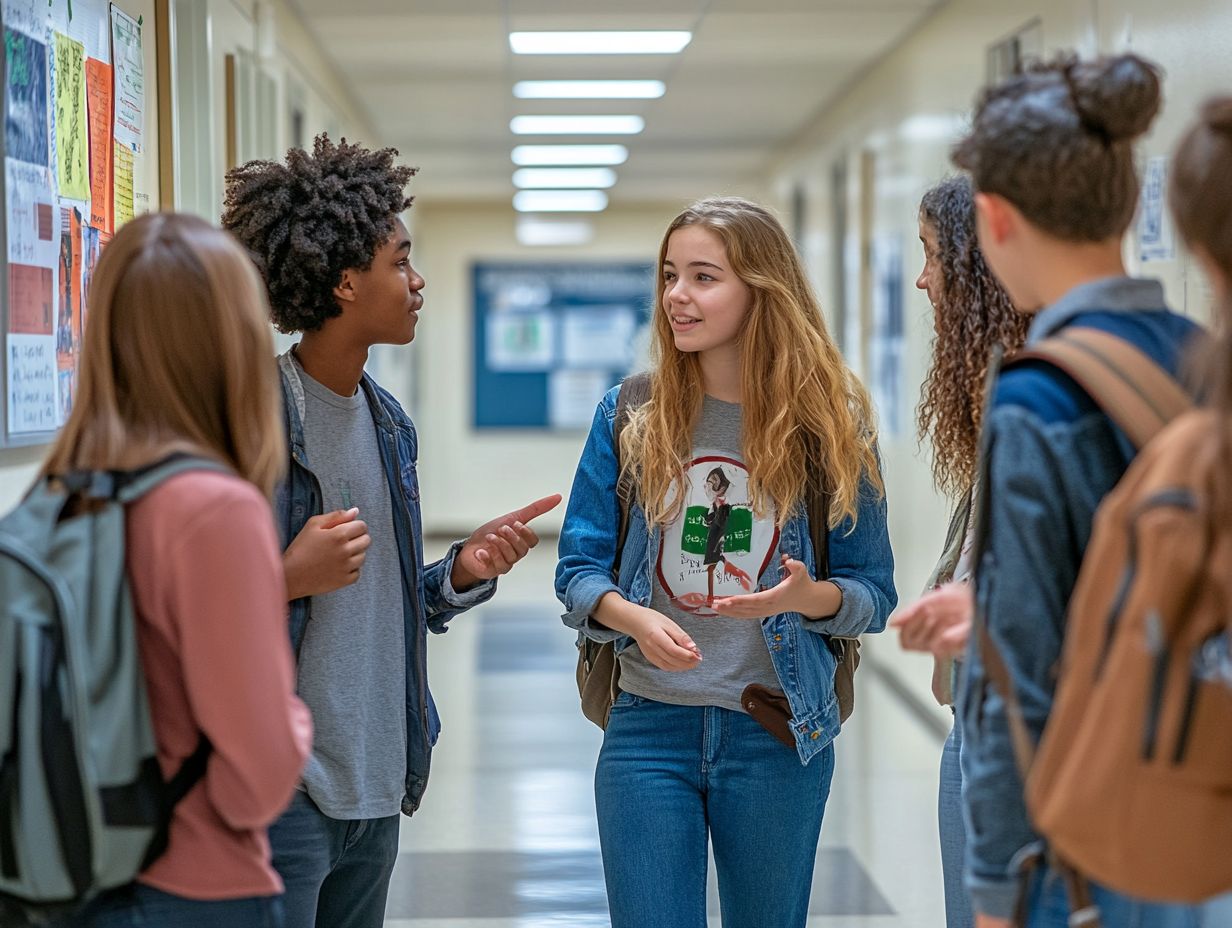What Are the Best Safety Tips for Students?
Student safety is an essential concern that influences every facet of campus life, from personal interactions to navigating the online landscape.
This discussion delves into crucial safety measures for you as a student, offering personal safety tips and awareness for public spaces. We will highlight valuable resources like campus safety services and hotlines.
You’ll discover tailored advice for various scenarios, such as campus life, travel, and social gatherings.
Stay informed to keep yourself safe in every situation!
Contents
- Key Takeaways:
- General Safety Tips for Students
- Safety Tips for Different Situations
- Resources for Student Safety
- Frequently Asked Questions
- What are the best safety tips for students living on campus?
- What are the best safety tips for students living off campus?
- What are the best safety tips for students using public transportation?
- What are the best safety tips for students studying abroad?
- What are the best safety tips for students attending parties or social events?
- What are the Best Safety Tips for Students Walking or Biking to Campus?
Key Takeaways:

- Always trust your instincts and take necessary precautions to ensure personal safety. This includes avoiding isolated areas and being aware of your surroundings at all times.
- Whether on campus, traveling, or in social settings, make sure to have emergency contacts and familiarize yourself with safety resources available. Communication and planning are key for staying safe.
- When using technology, be mindful of online safety measures and how to protect personal information. Utilize campus safety services and hotlines for additional support and assistance.
Why Student Safety is Important
Student safety is of utmost importance, ensuring a secure learning environment for parents, students, and school staff alike. A thoughtfully implemented safety protocol protects against emergencies like natural disasters or active assailants.
It also tackles bullying and harassment, which can take a significant toll on students mental health and emotional well-being.
By working together as a community guardians, school administrators, and local resources you can craft a comprehensive strategy for ensuring safety in educational institutions throughout the school year.
When students feel secure, they are far more likely to engage in their academic endeavors, leading to enhanced learning outcomes. For example, schools that conduct regular drills for emergencies, such as fire or lockdown procedures, equip students with the knowledge and tools needed to respond effectively in crises.
Anti-bullying programs that promote reporting and offer support services not only cultivate a respectful atmosphere but also strengthen students’ resilience.
This collaborative approach boosts mental health support systems and encourages community involvement. Local organizations can contribute valuable resources and training, enriching the overall safety culture within schools.
General Safety Tips for Students
General safety tips for students encompass a spectrum of practices designed to cultivate a secure environment, both physically and emotionally, throughout the school year. These guidelines not only encompass personal safety measures like maintaining open lines of communication with parents and guardians but also extend to transportation safety, ensuring that students arrive and depart from school safely.
By embracing these safety measures, students, parents, and school administrators can work together to foster a culture of safety that resonates throughout the community.
Personal Safety Measures
Implementing personal safety measures is crucial for you as a student to cultivate solid security habits and enhance your overall awareness in various settings. This could involve crafting an emergency action plan that outlines the steps to take during an emergency.
Additionally, adopting crime prevention strategies, like staying mindful of your surroundings and building trust with your neighbors, is essential.
By nurturing a sense of responsibility and vigilance, you can better protect yourself while contributing to a safer community.
It s essential for you to practice these emergency plans through regular drills, ensuring you re prepared for any unexpected situations. Engaging in community watch programs can help strengthen your connections with neighbors, fostering trust and making everyone more alert to suspicious activities.
You should also consider participating in safety workshops, where you can learn self-defense techniques and hone your situational awareness skills. This collaborative effort enables you and creates a culture of safety, making it increasingly difficult for criminal behavior to take root in your environment.
Safety in Public Spaces
Safety in public spaces is very important as you move around environments outside of school, including parks, public transportation, and community events.
By implementing transportation safety measures, understanding emergency procedures, and practicing effective communication, you can significantly enhance your safety in these settings. Staying informed about local public safety resources and protocols will enable you to respond appropriately in emergency situations.
To ensure your safety, adopt specific strategies, such as familiarizing yourself with local transportation routes and keeping emergency contact numbers handy. It’s wise to use public transportation during peak hours when more people are around, as this increases visibility and support. Practicing situational awareness, like avoiding distractions from your mobile devices, plays a crucial role in your personal safety.
Schools and local authorities help you by establishing clear communication methods, such as text alerts or safety workshops, to educate you on responding effectively during emergencies. This will ensure you feel enabled and prepared every time you step outside.
Online Safety

In today’s increasingly digital landscape, online safety has become a very important concern for you, whether you’re a student, parent, or educator. It’s essential to grasp the risks tied to social media, gaming, and online communication to safeguard against bullying, harassment, and cybersecurity threats.
Utilizing awareness resources like educational materials and community programs enables you to navigate the online world with confidence and responsibility.
Recognizing the signs of online bullying is vital for fostering a supportive atmosphere. You need to be mindful of your digital footprint and engage in healthy online interactions, while parents must take an active role in monitoring their children’s activities and discussing the significance of privacy settings.
Implementing cybersecurity best practices such as creating robust passwords and steering clear of suspicious links can drastically diminish the likelihood of data breaches. By leveraging these resources and knowledge, you can contribute to a collective effort within your community to cultivate a safer online experience for everyone involved.
Safety Tips for Different Situations
Safety tips tailored for various situations are essential for students as they navigate the complexities of their daily lives. By embracing a community-centric mindset, you can equip yourself to handle personal emergencies, whether they arise in school or during extracurricular activities.
Understanding the profound influence of mental health on your overall well-being is equally crucial. By adapting safety strategies to fit specific contexts, you not only enable yourself but also contribute to a shared sense of security among parents, guardians, and school administrators.
Safety on Campus
Safety on campus is very important for you as a student, and it hinges on your understanding of emergency procedures, leveraging campus safety services, and maintaining clear communication with your peers and faculty. It’s essential to familiarize yourself with vital safety protocols know important emergency contacts and resources and build trust with your neighbors and classmates to foster a supportive community.
Institutions often offer safety workshops designed to educate you on how to respond effectively in emergencies, such as fire evacuations or lockdown procedures. Access to campus safety apps can enhance your communication, allowing for swift reporting of any suspicious activity or requests for medical assistance. Many schools have dedicated safety officers ready to support you and address incidents promptly.
Encouraging your participation in safety drills boosts your awareness and enhances your preparedness. These resources enable you to cultivate a campus culture where safety is embraced as a shared responsibility among all students.
Stay safe and informed!
Safety while Traveling
Prioritize transportation safety for your well-being. Understand how to respond during emergencies.
Be aware of your surroundings and familiarize yourself with various modes of transportation, such as rideshares and public transit. This knowledge will help you choose the safest routes.
Preparing for emergencies is also key. Pack a small safety kit with essentials like a portable phone charger and first-aid supplies to make a difference in challenging situations.
Talk openly with trusted friends or family. Share your travel plans and check in regularly to keep everyone informed.
By taking these proactive steps, you can embark on your travels with greater confidence and peace of mind.
Safety in Social Settings
Safety in social settings is crucial as you navigate various interactions both inside and outside of school. Understand the risks associated with bullying and harassment, as well as the emotional and health concerns involved.
Develop crime prevention strategies and sharpen your communication skills to advocate for your safety and that of your peers.
When you foster an environment where discussing experiences feels comfortable, you can recognize the signs of bullying and harassment early on. Encouraging open dialogues not only builds awareness but also reinforces the importance of emotional well-being. A strong support system among friends and school staff is vital in making you feel secure and valued.
Learn to set personal boundaries to enhance your confidence. This equips you to address inappropriate behaviors and seek help when necessary. By cultivating these skills, you contribute to a safer, more supportive community for everyone.
Resources for Student Safety

Resources for student safety are essential for equipping you, along with parents and school administrators, with the tools and information to navigate potential safety concerns effectively.
Access awareness resources and campus safety services to ensure you have the support you need. Additionally, hotlines and support services offer immediate assistance during emergencies or crises.
Join the effort to create a safer learning environment by leveraging these resources.
Campus Safety Services
Campus safety services are vital support systems that provide access to emergency procedures and resources for public safety. These services often include safety patrols teams that help keep you safe on campus emergency call boxes, and well-trained personnel ready to respond to various situations. By fostering effective communication between you and the safety staff, campuses ensure that safety protocols are clearly understood and implemented efficiently.
Many schools also offer safety education programs to equip you with critical skills for emergencies. Strategic partnerships with local law enforcement agencies bolster these services, ensuring prompt responses in times of crisis. Initiatives like campus escorts, safety apps, and regular safety drills are instrumental in cultivating a culture of awareness and readiness.
These resources instill a sense of security in you, reinforcing that your institution prioritizes your safety and well-being. Ultimately, a proactive approach to campus safety not only protects individuals but also nurtures a thriving academic environment where you can flourish.
Hotlines and Support Services
Hotlines and support services are essential resources for you when you need immediate help. Don’t hesitate to reach out! These resources offer guidance concerning safety issues, including mental health challenges, bullying, and harassment. They provide confidential support, ensuring you have a safe space to express your concerns and seek help.
By utilizing these resources, you can effectively tackle your challenges and enhance your overall well-being.
In today’s educational landscape, where stress can increase due to academic demands and social dynamics, these services are crucial. They provide not just a listening ear but also professional counseling to help you navigate difficult situations.
Organizations offer dedicated hotlines that operate around the clock, allowing you to reach out at any hour, whether for urgent crises or general advice. Many schools also have on-site counselors and peer support groups, fostering a community where you feel enabled to share your experiences.
This collaborative ecosystem is vital in addressing issues like bullying and mental health challenges, ultimately creating a safer and more supportive academic environment for you.
Frequently Asked Questions
What are the best safety tips for students living on campus?
- Always lock your dorm room or apartment when leaving, even if it’s just for a minute.
- Avoid walking alone at night and use well-lit paths when walking on campus.
- Keep emergency contact numbers saved in your phone and make sure it is easily accessible.
- Avoid posting your class schedule or whereabouts on social media to prevent potential stalkers.
- Keep your personal information, such as address and phone number, confidential.
- Trust your instincts; if something or someone makes you feel uncomfortable, avoid them.
What are the best safety tips for students living off campus?

- Invest in a good quality lock for your doors and windows.
- Install a security system, a device that helps keep your home safe, or motion sensor lights outside your home.
- Keep your windows and doors locked, even when you are at home.
- Get to know your neighbors and exchange contact information in case of emergency.
- Avoid keeping large amounts of cash or valuables in your home.
- Be aware of your surroundings and report any suspicious activities to the authorities.
What are the best safety tips for students using public transportation?
- Plan your route beforehand and avoid using public transportation late at night.
- Sit near the driver or other passengers, if possible.
- Keep your personal belongings close to you at all times.
- Avoid wearing headphones or being distracted by your phone while waiting for or using public transportation.
- If you are feeling uncomfortable, move to a different seat or get off at the next stop.
- Report any suspicious or inappropriate behavior to the authorities or the transportation company.
What are the best safety tips for students studying abroad?
- Research the country and its customs before your trip to avoid any cultural misunderstandings.
- Keep a copy of your passport and important documents with you at all times.
- Be aware of local laws and customs and adhere to them.
- Stay in touch with your study abroad program and inform them of your whereabouts.
- Avoid traveling alone in unfamiliar areas and let someone know your plans.
- Use caution when using public Wi-Fi and be careful when sharing personal information.
- Avoid drinking excessively and know your limits.
- Always have a designated driver or use a ride-sharing service.
- Keep an eye on your drink and do not accept drinks from strangers.
- Stay with a group of friends and never leave with someone you do not know.
- Trust your instincts and leave if you feel uncomfortable.
- If you witness any suspicious or dangerous behavior, report it to the host or authorities.
Stay safe and empowered! Reach out for help when you need it.
What are the Best Safety Tips for Students Walking or Biking to Campus?
1. Stay on well-lit paths where other people are present.
2. Wear reflective clothing when walking or biking at night. This helps others see you easily.
3. Follow all traffic laws and signals to keep yourself safe.
4. Always use a bike lock to secure your bike when you leave it. This prevents theft!
5. Avoid wearing headphones while walking or biking. Stay alert and aware of your surroundings.
6. Walk or bike with a friend or in a group whenever possible. It s safer and more enjoyable!






